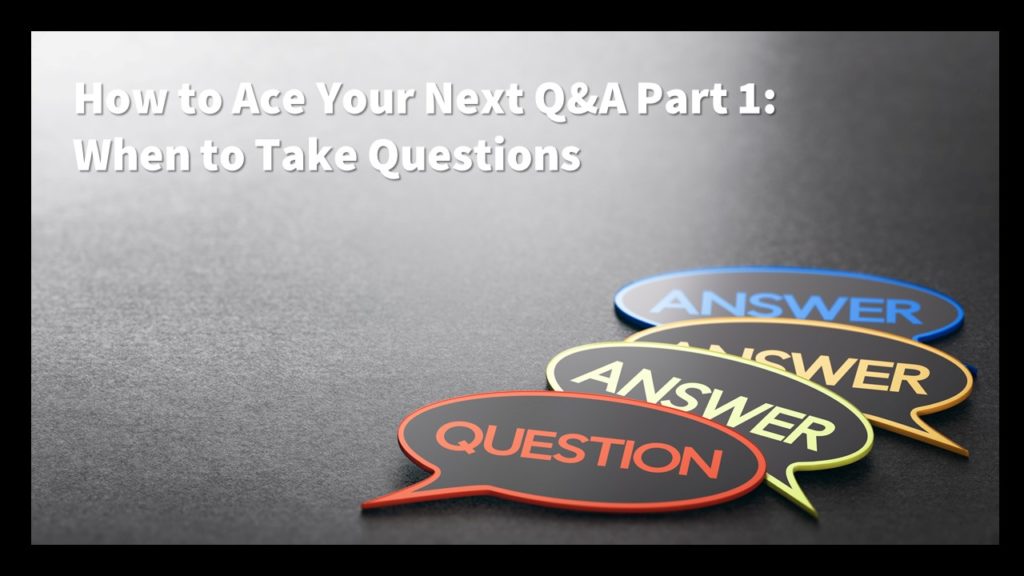How to Ace Your Next Q&A Part 1: When to Take Questions
This post is part of a four-part series that will teach you how to prepare for and conduct effective, memorable, and meaningful question-and-answer sessions.
Not every presentation calls for a Q&A session. Some persuasive or motivational talks can suffer from anti-climactic Q&A sessions that leave audiences crashing back down to earth. A moderator-led panel discussion doesn’t always require audience participation.
But there are often huge advantages for speakers who welcome audience questions, which is why we advise doing so in most circumstances.

There are several different times you can take questions during a presentation. Sometimes, the timing of when audience members can ask questions is obvious to them (participants in a six-person training workshop would likely know they can ask questions as they arise). If your format is less obvious, reveal your intentions for handling questions during your post-open.
Here are four ways to engage:
1. Take Questions Throughout Your Talk
This approach is particularly audience-friendly and works well for informal gatherings, training seminars, many business presentations, and small-to-medium sized audiences. It’s the most common format, for good reason.
Still, we hear an almost universal concern with this approach: What if the questions keep coming, or are about material I had planned to cover later, and derail the flow of my presentation?
Those are valid, but manageable, concerns. If the questions keep coming, you might say, “Let’s take one more question for now, then I’ll share some additional information that will help inform our discussion.” If a question comes before you had planned on covering the topic, you have three choices:
- You can skip ahead and answer it when it’s asked, which may be necessary if the question comes from a boss or potential customer.
- You can promise to answer it later.
- Or, you can use a hybrid approach I call “short answer and punt,” in which you offer a high-level response and pledge to offer a more complete answer later (“The short answer is yes, although there are a few situations in which that’s not the case. I’ll detail those shortly.”).
2. Take Questions at the End
There are good reasons to hold questions until the end of your talk. If you are building to a surprising conclusion, questions taken midstream could slow or interrupt the dramatic pacing. Or, if you are speaking before a particularly large audience, questions throughout your talk could prove unwieldy. If you choose this option, let your audience know you will allow plenty of time for questions at the end – and then manage the time properly so you can keep your promise.
But if the only reason you choose this option is because you would feel more comfortable getting through your prepared remarks before allowing questions, please reconsider. By the time you get to the end, you may discover you lost some audience members early on because a point wasn’t clear to them, or that you allowed resistance to build because you didn’t allow concerns to be expressed before they hardened.

3. Take Questions in Segments
If your presentation is divided into, say, three main topics, you can pause for questions after each one before moving to the next. This approach can be the best of both worlds, allowing you to get through a chunk of material and the audience to ask questions or comment while the material remains timely.
When you open the floor to questions after each topic, you can say, “Let’s spend the next five minutes addressing any questions or comments regarding this topic.” When it’s time to move on to your next point, reclaim the floor with this: “Let’s take one more question or comment now, and then we’ll move on to the next topic.”
4. Take Questions in Writing
There are times when it may be more effective to solicit comments and questions by pen to paper or finger to screen, such as keynote speeches, larger panel discussions, or when audiences are tuning in remotely. In each of those cases, a moderator should help screen the questions.
You or your moderator should inform your audience at the beginning about the process for submitting questions. Queries can be jotted down on file cards left on the audience’s seats and collected at the end of your or the panel members’ remarks. Or, for more tech-savvy groups, your audience can post questions – in advance and/or throughout your talk – on social media platforms by using a specific hashtag or through a conference-specific app.
Screening questions in advance doesn’t mean ducking tough questions, though, which the audience will see through and resent. Remember: challenging (but fair) questions can be a gift to speakers, so you should relish the opportunity to persuade your audience to your point of view.
Previous posts in this series:


